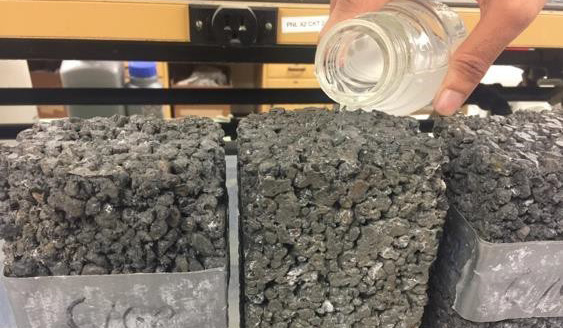Pervious concrete holds great potential to mitigate the effects of deicers in stormwater runoff in cold regions and to support environmental conservation. This study provided a better understanding of the freeze/thaw and salt scaling resistance of pervious concrete modified with fly ash, with or without graphene oxide.
Pervious concrete is very porous, allowing precipitation and other fluids to pass through directly. The infiltration effect provided by pervious concrete pavements not only can recharge the groundwater but can also reduce the amounts of total suspended solids, phosphor, nitrogen, and metals in the ground water.
The results of Phase I of this project suggested the potential for using pervious concrete modified with graphene oxide (GO) fly ash in pavement. The primary objectives of Phase II of this project were (1) to evaluate the stormwater infiltration capacity of GO-modified fly ash pervious concrete; (2) to evaluate the durability performance of GO-modified fly ash pervious concrete using freeze/thaw and salt resistance testing methods; and (3) to use advanced analytical tools to fully characterize the GO-modified fly ash binder.
Test results indicated different degrees of reduction in concentrations of possible pollutants in stormwater, such as copper, zinc, sulphate, chloride, ammonia, nitrate, and total phosphate.
The incorporation of GO significantly improved the resistance of pervious concrete to freeze/thaw cycles, ambient-temperature salt attack, and “salt scaling” of pervious concrete, for both the cement and activated fly ash binder.
The specimens were examined with X-ray diffraction, which revealed that the mineralogy and the chemical composition of fly ash pastes differ considerably from those of cement pastes. Nuclear magnetic resonance was used to study the chemical structure and ordering of different hydrates, and provided enhanced understanding of the freeze/thaw and salt scaling resistance of fly ash pervious concrete and the role of GO.
Authors:
Xianming Shi
Gang Xu
WSU Department of Civil and Environmental Engineering
Sponsor: Center for Environmentally Sustainable Transportation in Cold Climates

